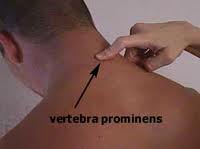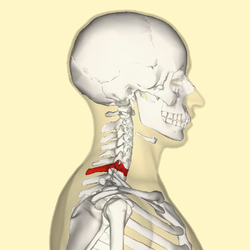What is Vertebra prominens?
Page Contents
It is the name given to the 7th cervical vertebra in humans.
Vertebra prominens Etymology
The word “vertebra” is derived from an old Latin word “verto” which means a joint; it can also refer to something that is to be turned. In A.D. 30, this word was used by Celsus to describe any joint of the body. It was only much later that the word began to be used to describe the 7th cervical vertebra.
Vertebra prominens Location
The structure is located on the upper part of the spinal cord.
Vertebra prominens Description
The most distinct characteristic property of this vertebral section is the prominently long spinous process that is easily apparent from skin surface. The spinous process is almost horizontal in direction, thick, not bifurcated and ending in a tubercle with which the lower portion of ligamentum nuchae is connected.
The 7th cervical vertebra or the C7 has got the most prominently detectable spinous process in nearly 70% of people. In the rest of the people, either the C6 or the first thoracic vertebra (T1) is the most prominently detectable spinous process.
Transverse processes generally have a considerable size. The posterior roots of these processes are quite large and prominent and the anterior portions are small. The upper area of the traverse processes usually has a shallow sulcus for 8th spinal nerve. Its extremity hardly presents any more than a hint of bifurcation.
Vertebra prominens Articulations
Vertebra prominens articulates with 2 other vertebrae, known as the superior neighboring vertebrae and the inferior neighboring vertebrae. Each typical vertebra is united by six articular surfaces. The 2 superior articular facets form articulations with the parallel inferior articular facets of adjacent vertebra. The inferior and superior surfaces of vertebral bodies create an articulation through the cartilaginous intervertebral disc.
Vertebra prominens Ossification
A total of five cartilaginous centers grow as anlage to all the vertebrae and ribs. The body is formed by one center, the costal elements are formed by two anterolateral centers and the vertebral arch is formed by two posterolateral centers. During the 3rd intrauterine month, the body anlage in this vertebra starts to ossify. At this point, the ossification points for the arch anlagen and costal appear as well as merge to form paired lateral centers. The 3 ossifying centers stay separated at birth. The 2 laminae unite during 2nd year. However, they do not join the body as long as they are 3 to 6 years of age. The fusion generally starts cranially and then progresses caudally. The secondary centers start appearing on tips of spinous and transverse processes as well as on the superior and inferior surfaces of bodies. The secondary centers start appearing during middle teen years and then fuse during mid-twenties.
Vertebra prominens Functions
This vertebral section functions along with the other vertebrae of the cervical spine, and provides support to the skull, allowing back and forth as well as side to side head movements. It also provides protection to the spinal cord from injuries.
Vertebra prominens Pictures
The images underneath show the physical appearance of this structure.
Picture 1 – Vertebra prominens
Picture 2 – Vertebra prominens Image
References:
http://www.anatomyexpert.com/structure_detail/26/
http://health.yahoo.net/human-body-maps/seventh-cervical-vertebra
http://en.wikipedia.org/wiki/Vertebra_prominens
http://www.gpnotebook.co.uk/simplepage.cfm?ID=-40239044


